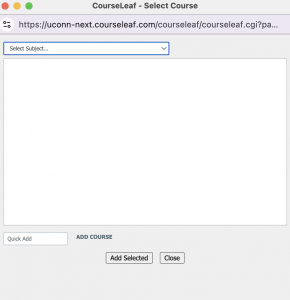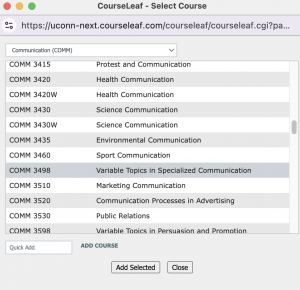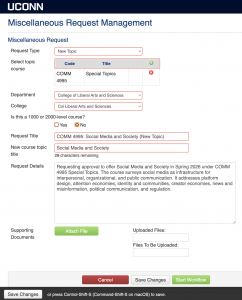At a glance:
At a glance: Special Topics courses (catalog numbers ending in xx95) are used to pilot new course ideas. They may be offered a maximum of three times before they must be proposed as a permanent course.
- Use case: Pilot new course content under an existing Special Topics shell (xx95).
- Offering limit: Up to 3 offerings total before permanent-course proposal is required.
- Approvals (CLAS): New topics require C&C approval (typically chair approval with report to the committee).
- Lower-division topics: If the topic is one of the small number of 1000- or 2000-level Special Topics courses, it also requires approval by the Senate C&C chair.
Tip: Confirm whether your topic is 1000/2000 level before submitting; this determines the workflow in the system.
Before You Start
Prepare the following:
- Working title for the topic (what students will see in Student Admin).
- Brief description and learning goals.
- Syllabus (PDF recommended) and any supporting materials.
- Hosting course shell (e.g., COMM 4995, HIST 2995, etc.).
- Department and College information.
- Course level (1000 or 2000) if applicable.
Submit a New Special Topics Proposal
- Open the form. Go to the Miscellaneous Request Management form:
https://uconn-next.courseleaf.com/miscadmin/ - Choose request type. In Request Type, select New Topic from the dropdown menu.
(It is currently the only option.) - Select the topic course shell.
Click the green “+” icon in the Select topic course field (#1), then choose the appropriate course shell from the window that opens (#2).
(Please note: this will happen in a pop-up window, so you may need to adjust your browser settings to allow it.)

(#1)

(#2)

- Set department and college.
Because the Miscellaneous form does not integrate with the main course form, you must manually select the Department and College. - Indicate the course level.
Specify whether the topic is 1000 or 2000 level . This ensures it follows the correct workflow, including Senate C&C chair review when required.
- Enter titles.
- Request Title: A short, clear label that lets proposers and reviewers quickly identify the submission (e.g., “COMM 4995: Social Media and Society (New Topic)”).
- New Course Topic Title: The exact title that will appear in Student Admin.
- Add details and attachments.
Provide a concise request description, then upload supporting attachments (e.g., syllabus, schedule, assessment overview). - Review and submit.
Confirm all fields, check routing/approvals, and submit.
After You Submit
- Routing: Your request routes based on level and the Department/College selections.
- Approvals: Expect chair approval with a report to CLAS C&C. 1000/2000-level topics will also be routed to the Senate C&C chair.
- Edits: If you’re asked for revisions, update the submission and resubmit.
FAQs
What counts as a Special Topics course?
A course offered under an existing xx95 shell to pilot new content.
How many times can I offer it?
Up to three offerings total before proposing it as a permanent course.
Do I need a full permanent-course proposal now?
Not for a Special Topics run. A permanent proposal is required after the pilot period if you want to continue offering it.
Who can help if I have questions?
Start with your department chair or your unit’s C&C representative. Additionally, you can contact Marc Hattfield in the Registrar’s Office at marcus.hatfield@uconn.edu.